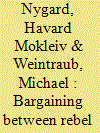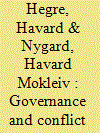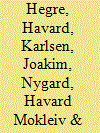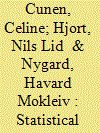|
|
|
Sort Order |
|
|
|
Items / Page
|
|
|
|
|
|
|
| Srl | Item |
| 1 |
ID:
140001


|
|
|
|
|
| Summary/Abstract |
Although military cooperation among rebel groups in multi-party civil wars could help rebels defeat or extract concessions from an incumbent government, violent conflict among rebel groups is empirically prevalent. Why do rebel groups in multi-party civil wars choose to fight one another? This article models the strategic dilemma facing rebel groups in multi-party civil wars as an alternating-offer bargaining game of incomplete information with an outside option. The game-theoretic model explores the relationship between the status quo distribution of power among rebel groups, the costs of fighting, and the likelihood that one rebel group will opt to unilaterally end bargaining over a set of goods, such as access to supply routes, natural resources, and control over civilian populations. We show that the likelihood of violent conflict between rebel groups is lowest when the status quo distribution of benefits reflects the existing distribution of power.
|
|
|
|
|
|
|
|
|
|
|
|
|
|
|
|
| 2 |
ID:
141188


|
|
|
|
|
| Summary/Abstract |
Many conflict studies regard formal democratic institutions as states’ most important vehicle to reduce deprivation-motivated armed conflict against their governments. We argue that the wider concept of good governance—the extent to which policy making and implementation benefit the population at large—is better suited to analyze deprivation-based conflict. The article shows that the risk of conflict in countries characterized by good governance drops rapidly after a conflict has ended or after independence. In countries with poor governance, this process takes much longer. Hence, improving governance is important to reduce the incidence of conflict. We also decompose the effect of good governance into what can be explained by formal democratic institutions and less formal aspects of governance, and into what comes from economic development and what is due to how well countries are governed. We find that informal aspects of good governance to be at least as important as formal institutions in preventing conflict and that good governance has a clear effect over and beyond economic development.
|
|
|
|
|
|
|
|
|
|
|
|
|
|
|
|
| 3 |
ID:
120869


|
|
|
|
|
| Publication |
2013.
|
| Summary/Abstract |
The article predicts changes in global and regional incidences of armed conflict for the 2010-2050 period. The predictions are based on a dynamic multinomial logit model estimation on a 1970-2009 cross-sectional data set of changes between no armed conflict, minor conflict, and major conflict. Core exogenous predictors are population size, infant mortality rates, demographic composition, education levels, oil dependence, ethnic cleavages, and neighborhood characteristics. Predictions are obtained through simulating the behavior of the conflict variable implied by the estimates from this model. We use projections for the 2011-2050 period for the predictors from the UN World Population Prospects and the International Institute for Applied Systems Analysis. We treat conflicts, recent conflict history, and neighboring conflicts as endogenous variables. Out-of-sample validation of predictions for 2007-2009 (based on estimates for the 1970-2000 period) indicates that the model predicts well, with an area under the receiver operator curve of 0.937. Using a p > .30 threshold for positive prediction, the true positive rate 7-9 years into the future is 0.79 and the False Positive Rate 0.085. We predict a continued decline in the proportion of the world's countries that have internal armed conflict, from about 15% in 2009 to 7% in 2050. The decline is particularly strong in the Western Asia and North Africa region and less clear in Africa south of Sahara. The remaining conflict countries will increasingly be concentrated in East, Central, and Southern Africa and in East and South Asia.
|
|
|
|
|
|
|
|
|
|
|
|
|
|
|
|
| 4 |
ID:
173884


|
|
|
|
|
| Summary/Abstract |
Have great wars become less violent over time, and is there something we might identify as the long peace? We investigate statistical versions of such questions, by examining the number of battle-deaths in the Correlates of War dataset, with 95 interstate wars from 1816 to 2007. Previous research has found this series of wars to be stationary, with no apparent change over time. We develop a framework to find and assess a change-point in this battle-deaths series. Our change-point methodology takes into consideration the power law distribution of the data, models the full battle-deaths distribution, as opposed to focusing merely on the extreme tail, and evaluates the uncertainty in the estimation. Using this framework, we find evidence that the series has not been as stationary as past research has indicated. Our statistical sightings of better angels indicate that 1950 represents the most likely change-point in the battle-deaths series – the point in time where the battle-deaths distribution might have changed for the better.
|
|
|
|
|
|
|
|
|
|
|
|
|
|
|
|
|
|
|
|
|